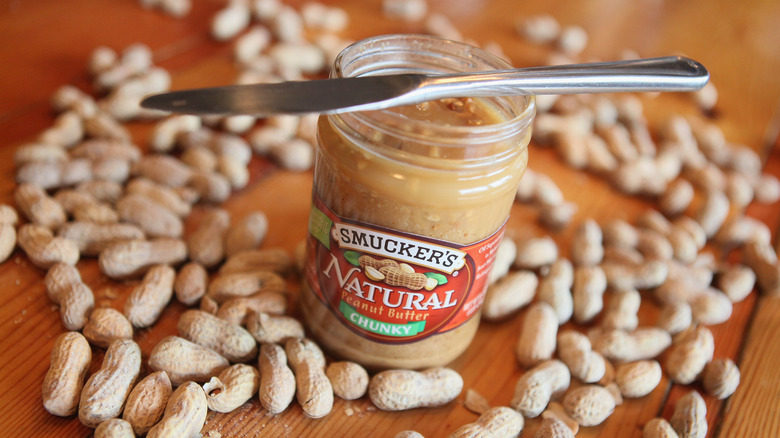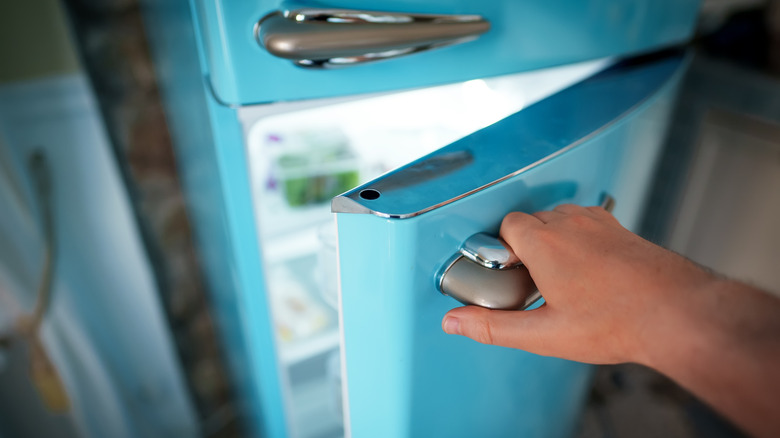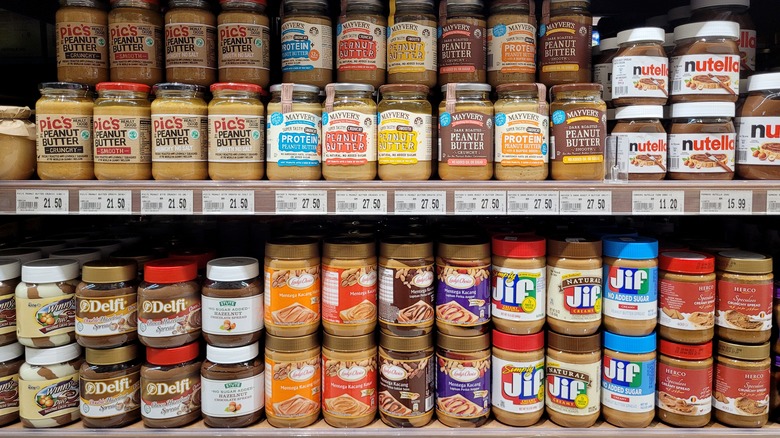The Case For Storing Peanut Butter In Your Fridge
There's not necessarily a single answer to the age-old question of how to store your peanut butter, but there is definitely a case to be made for keeping it in the fridge. Especially if natural peanut butter is your jam. (See what I did there?)
There are essentially two different types of peanut butter: You have your commercially processed peanut butters — think Jif or Skippy — that contain preservatives such as hydrogenated oils. These additives are intended to stop the process of syneresis, or the separation of ingredients, and to extend shelf life. Then you have your natural peanut butter, which is made simply with roasted peanuts and some salt. Without the laundry list of stabilizers, the oil in the peanuts naturally rises to the top of a jar of natural peanut butter and leads to a layer of oil on top of the denser peanut solids. Sure, you can give your jar a stir to redistribute the oil, but the separation will continue to occur over time.
Cue the refrigerator. Storing your natural peanut butter in the fridge can help slow the syneresis and firm it up. Keeping it at a cooler temperature can also inhibit mold growth and keep it from spoiling.
Other hacks to keep your peanut butter ready-to-use
Be aware, though, that there are some drawbacks to storing peanut butter in the fridge, natural or not. The cold temperature can cause the peanut butter to stiffen and harden, making it more difficult to spread, especially if it's a chunky variety.
But there is another hack to keeping your natural peanut butter's consistency intact without refrigeration: Turn it upside down. Storing natural peanut butter upside down can help redistribute the oils throughout the jar, preventing the oil from pooling at the top. This simple trick will deliver a more consistent texture when you open the jar, making it easier to mix in the separated oil before each use. Storing the jar this way can make it easier to stir the peanut butter since the oil will settle at the bottom and allow for a smoother and potentially less messy mixing process.
Sometimes a bit more effort is needed to fully re-emulsify the peanut butter if it's been sitting upside down for a while. Depending on the size of the jar, you could try to use an immersion blender to redistribute the oil, or one side of a hand mixer. Or just flip the jar and give it a good shake!
Shelf life of peanut butter
In the pantry, unopened jars of peanut butter are good for up to nine months when stored in a cool, dry place away from direct sunlight. An open jar of peanut butter in the pantry will last about one to three months for optimal flavor and texture, depending on what kind of peanut butter it is. Storing peanut butter in the fridge can extend its shelf life considerably, keeping it fresh for six to nine months after opening.
When storing peanut butter, be sure to keep the lid tightly sealed to prevent air and moisture from getting in, which can lead to spoilage. This is especially true for natural peanut butters and homemade nut butters. "The separated oil in unrefrigerated natural peanut butter is more likely to become rancid sooner, leading to unpleasant taste and texture," Margarethe A. Cooper, PhD, assistant professor of practice and Victor P. Smith Endowed Chair in Food Safety Education at the University of Arizona, told Martha Stewart.
Before using refrigerated peanut butter, you also want to allow it to come to room temperature for easier spreading, and always give it a good stir to redistribute any of those pooled oils.


